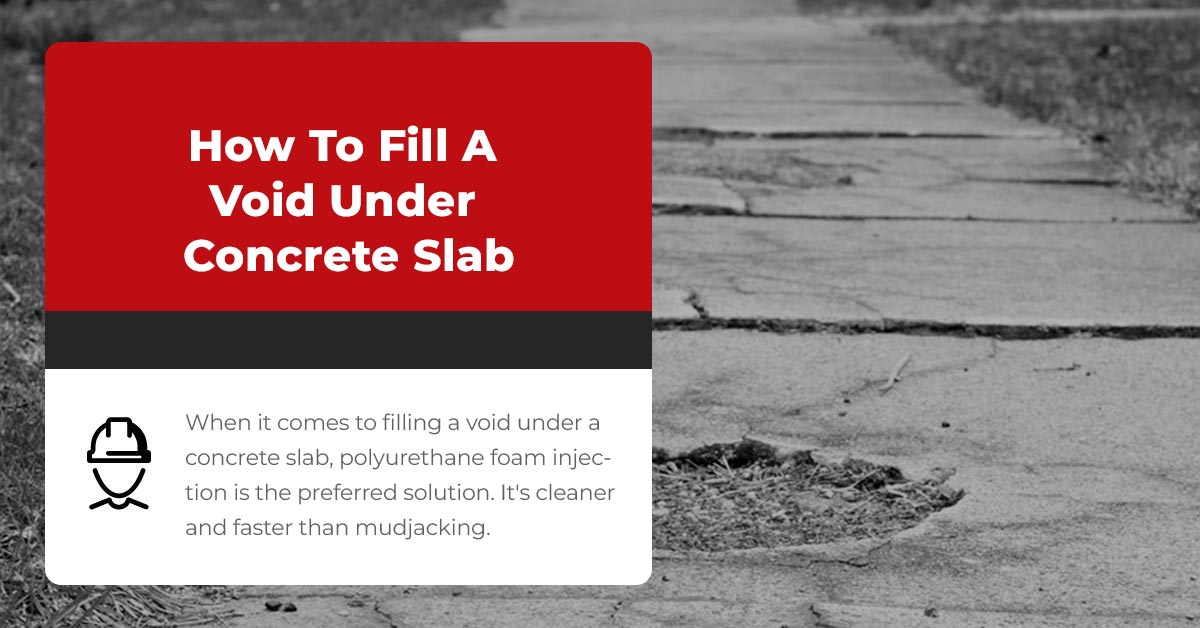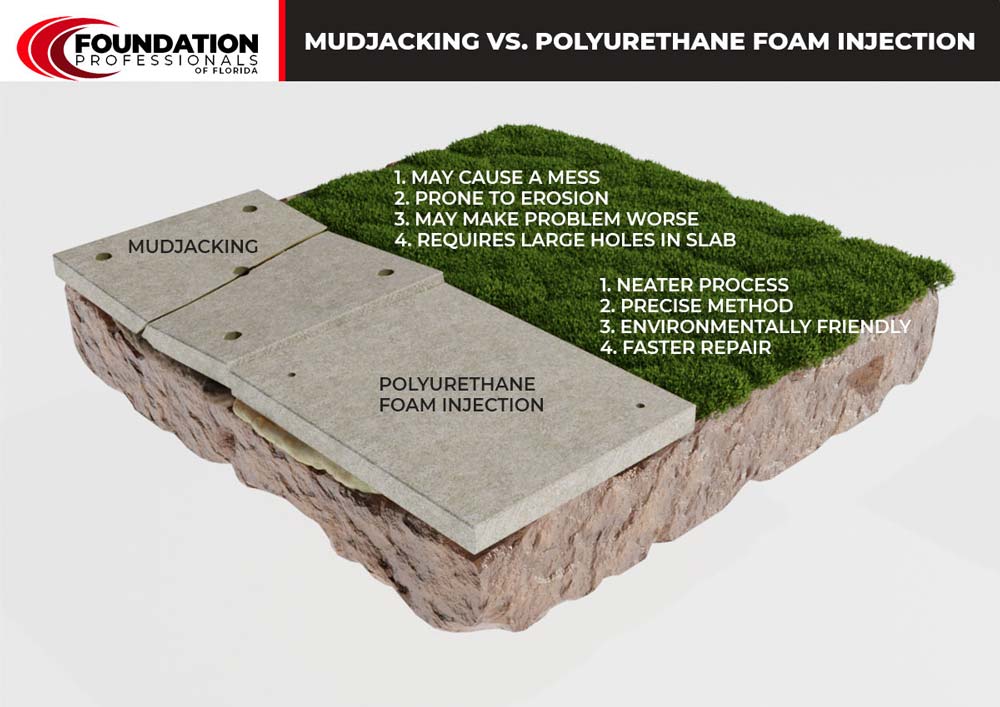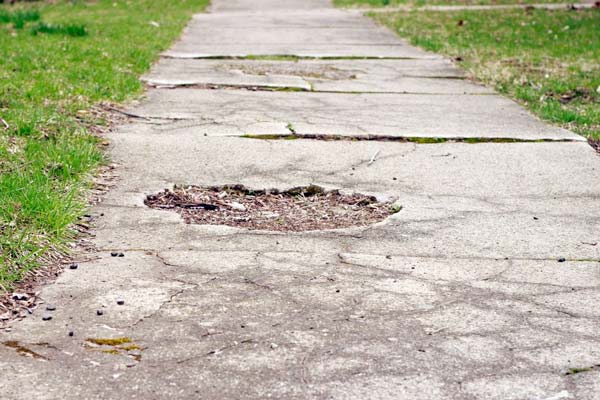Searching for information on how to fill a void under a concrete slab? If so, don’t hit that back button because you’ve landed on the right page. In this article, we’ll go over what causes voids to form under concrete slabs such as sidewalks and driveways, how to fill a void under a concrete slab, repairing an uneven slab vs. replacement, and more.
What Causes Voids To Form Under Concrete Slabs?
Voids, or spaces underneath concrete slabs, occur due to a variety of factors, including the following:
- Inadequate compaction of the underlying soil – If the soil underneath the slab is not sufficiently compacted before the slab is poured, it can shift over time, creating empty spaces or voids.
- Poor drainage – Water can infiltrate the soil beneath the pavement, causing it to soften and erode. As the soil is washed away, voids can form underneath the slab. This is especially common in areas with heavy rainfall or poor drainage.
- Soil settlement, erosion, or the decay of organic matter in the soil – These processes can cause the soil under the slab to shift or compress, creating empty spaces that can eventually lead to the collapse of the pavement.
Voids can weaken the structural integrity of the slab, making it more susceptible to cracking and collapse. In addition, they can also create trip hazards for pedestrians.
To prevent void formation, precautions during the installation process are essential. This includes ensuring the soil is properly compacted, and adequate drainage is in place. (We’re going to talk more about prevention below.) Properly poured concrete slabs can last for many years, but taking steps to prevent void formation is essential.
How To Fill A Void Under A Concrete Slab
Mudjacking vs. polyurethane foam injection
When it comes to voids under a concrete slab, it’s important to address the issue as soon as possible before it becomes a bigger problem. One method of correcting this problem is filling the voids beneath the concrete slab. This can be done using either mudjacking or polyurethane foam injection, but which is the better choice?
Mudjacking
Mudjacking is the old-school way of leveling uneven concrete slabs such as driveways, sidewalks, patios, and pool decks. Although it’s still being done today, it’s not as popular as it once was.
Mudjacking involves drilling small holes into the concrete and then pumping a slurry mixture of water, soil, and cement through the holes. The slurry fills the voids beneath the slab, and the pressure of the mix raises the concrete back to its original position. Unfortunately, mudjacking has its downsides. These include the following:
- Mudjacking can be a dirty job, as the slurry mixture can spill out and cause a mess on the property.
- The slurry used in mudjacking is prone to erosion because it contains soil.
- The mudjacking slurry is also heavy. If the soil under the sidewalk or driveway was already struggling to hold up the slab, adding a heavy cement slurry isn’t going to help things. It could even make the problem worse.
- Finally, the holes required for mudjacking are larger than those needed for polyurethane foam injection. This will impact the aesthetics of the outcome.
Polyurethane Foam Injection (also known as polyjacking)
Today, polyurethane foam injection is the preferred method for filling voids to lift and level an uneven concrete slab.
Polyurethane foam is an expanding foam that contains two chemicals that mix in the nozzle and react to create a foam that hardens within minutes. The foam is injected into the soil beneath the slab through small, dime-sized holes and quickly expands to fill any voids. The foam is lightweight but very strong.
The benefits of filling voids under a concrete slab via polyurethane injection instead of mudjacking include the following:
- Polyurethane foam injection is a neater process than mudjacking. There’s no mess since the foam stays under the slab and doesn’t spill out.
- Polyjacking is a much more precise method of filling voids because the foam can be injected exactly where needed.
- Polyurethane foam is a green solution. Because the foam doesn’t leach into the soil, it poses no environmental threat.
- Polyurethane foam injection takes less time to complete than mudjacking. Most jobs can be completed in just a few hours, and then the slab is ready for use again.
Today, polyurethane foam injection is the preferred solution when it comes to filling a void under a concrete slab. It’s cleaner, faster than mudjacking, and environmentally friendly.
Repairing A Slab Vs. Replacement
When repairing a concrete slab such as a sidewalk or driveway, a few variables must be considered before deciding whether to repair or replace it. These include the age of the slab, the extent of the damage, and the cost of repair.
If the concrete slab is relatively new and has only minor damage, such as cracks, small holes, or unevenness due to voids under the slab, it may be possible to repair the slab.
Several repair options can be employed to fix such damage, including resurfacing, patching, and polyurethane foam injection:
- Resurfacing involves applying a thin layer of new concrete over the existing slab.
- Patching involves filling the cracks or holes with a cement-based mortar mixture.
- As discussed above, Polyurethane foam injection can fill any voids under the slab.
All three methods can effectively restore the structural integrity and appearance of the slab. Moreover, repairing a small section of a large concrete slab like a sidewalk is typically more cost-effective than replacing the entire slab.
If the concrete slab is old and extensively damaged, replacing it may be the best option. This is because weather conditions and corrosion might weaken the concrete, and deep cracks or large chunks may be missing. If this is the case, repairing the slab would only provide a short-term solution, as the slab will likely incur further damage. Replacing the slab allows upgrading to more durable or aesthetically pleasing materials.
When considering whether to repair or replace a concrete slab, it’s essential to consult a professional to evaluate the extent of the damage and recommend the best course of action.
How To Prevent Voids Under A Concrete Slab
Preventing voids under a concrete slab such as a sidewalk or driveway is essential to ensure the structural integrity and longevity of the pavement. Voids, or empty spaces, beneath a concrete slab, can cause settling, cracking, and sinking, leading to costly repairs.
Ensure good drainage under the slab
One of the most important preventive measures against voids is proper drainage. Poor drainage can cause water to accumulate beneath the slab, leading to erosion, soil instability, and voids. A well-designed drainage system that directs water away from the pavement will help prevent voids from forming. This can include installing surface and french drains or a gravel base beneath the concrete to facilitate water drainage.
Proper preparation of the subgrade
Another critical factor to consider when preventing voids is subgrade preparation. The subgrade refers to the soil or material below the concrete slab. The subgrade must be well-compacted and leveled to prevent any weak spots or low areas that could lead to voids forming. Additionally, installing a geotextile fabric layer between the subgrade and the base material can help prevent soil erosion and maintain stability.
Choosing the appropriate base material for the concrete slab is also crucial in preventing voids. The base material supports the slab’s weight and distributes it evenly across the surface. Poor-quality or inadequate base materials can lead to settling and voids. High-quality base materials such as gravel or crushed stone provide adequate drainage and support while resisting settling and void formation.
Furthermore, control joints are essential in preventing voids because they allow the concrete to expand and contract as it interacts with the climate. Without control joints, concrete will crack and expose it to the risk of voids.
If you’re concerned about voids under a concrete slab on your property, contact Foundation Professionals of Florida today and make an appointment for an evaluation.



